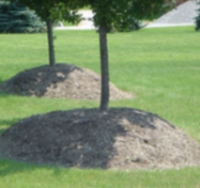Mulch is defined as “A protective covering, usually of organic matter such as wood chips, straw, or peat, placed around plants to prevent the evaporation of moisture, the freezing of roots and the growth of weeds”.
Key Points
- The recommended depth for mulch is 2 to 4 inches.
- Always keep mulch several inches away from trees and shrubs so that the base of the trunk and root crown are exposed.
- Mulch piled against the trunk of a tree can lead to decay, rot and the death of the tree.
- Never pile rocks or other materials against the trunk of a tree.
Tree Damage
The benefits of mulch are clear but the potential negative affects to trees are substantial. If applied too deep or if the wrong material is used, it can cause serious harm to trees. Mulch should not exceed 2 to 4 inches in depth to prevent root rot caused by excessive moisture in the root zone. Mulch piled against a tree trunk can cause rot and decay of the trunk resulting in structural weakness and possibly the eventual death of the tree. If piled against the trunk of young trees, mulch can provide a habitat for rodents that chew the bark resulting in girdling.
Control Measures
If you already have mulch around your trees be sure to pull it back several inches from the base so that the trunk of the tree and the root crown are exposed. It is better to spread mulch over a wide area out to the drip line (or beyond) at a depth never exceeding 2 – 4 inches than to pile it near the tree base.Organic mulches are recommended over inorganic materials since they provide nutrients and improve the quality of the soil. Wood chips make good mulch especially if they contain a mix of leaves, bark and wood.
Proper Mulching
Mulch should be about 4 inches deep and should be kept at least a couple inches away from the trunk of the tree. Mulching out to the dripline ( the distance the longest branches extend to) is recommended. Organic mulches will require replenishing every few years, but also have the added advantage of helping to replenish nutrients in the soil.




